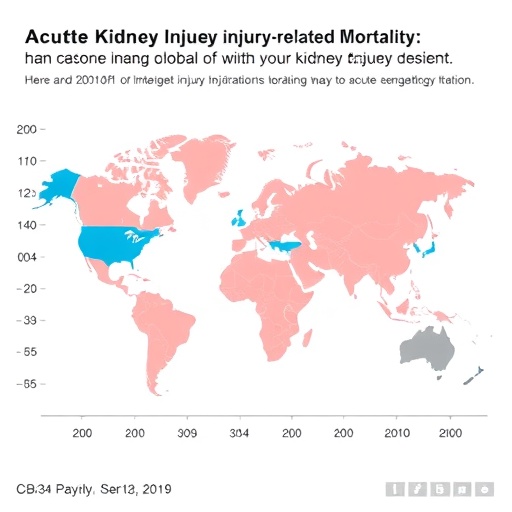A comprehensive five-year investigation into global acute kidney injury (AKI) related mortality trends has illuminated a complex and evolving landscape, revealing a startling divergence in outcomes between countries based on socioeconomic status and demographic profiles. This monumental analysis, covering data from 1996 to 2021 across 43 diverse nations, identifies a paradoxical increase in mortality rates among older populations in wealthy countries contrasted against a decline in less affluent regions. Findings from this landmark study were unveiled at the American Society of Nephrology’s prestigious Kidney Week 2025 conference in Houston, Texas, setting a new benchmark for global nephrology research.
The study meticulously utilized the World Health Organization Mortality Database, allowing researchers from Kyung Hee University Hospital in Seoul to perform an unparalleled temporal examination of AKI-related death trends. Their analysis revealed that while low- and middle-income countries have experienced encouraging declines in AKI mortality, likely driven by demographic shifts towards younger populations and advances in infectious disease management and healthcare accessibility, high-income countries have confronted an unsettling rise. This increase is attributed to multifactorial influences including advanced population aging and an escalating burden of comorbid conditions that complicate AKI prognosis.
Specifically, the surveillance data draws attention to older adults, with a pronounced emphasis on females residing in high socioeconomic environments, as a demographic increasingly vulnerable to AKI-related fatality. The intersection of aging physiology and prevalent chronic illnesses in these regions creates a fertile ground for AKI complications. Projections extending to 2050 forecast a gradual, yet persistent, rise in global AKI mortality, underscoring the critical urgency for tailored intervention frameworks that address unique regional, age-specific, and sex-specific challenges in AKI prevention and management.
Notably, the research also draws nuanced distinctions between crude mortality rates and adjusted mortality patterns. High-income countries, despite having traditionally lower baseline AKI mortality rates, are now witnessing incremental increases. This paradox evidently aligns with demographic transformations characterized by an expanding elderly population and increased incidence of non-communicable diseases such as diabetes, hypertension, and cardiovascular conditions that synergistically exacerbate susceptibility to severe AKI outcomes. Meanwhile, the descending mortality trajectory in less affluent nations is linked to broader public health successes, particularly in reducing infection-related AKI triggers through improved vaccination coverage, antimicrobial therapies, and enhanced healthcare infrastructure.
Lead investigator Dr. Hyeon Seok Hwang, MD, PhD, articulates that this global, longitudinal statistical modeling and time series analysis provides the first comprehensive, evidence-based insight into AKI-related mortality trends and their underlying determinants. Their findings herald vital implications for disease modeling and health policy, advocating for priority shifts in healthcare resource allocation and strategy development. The urgent call from co-author Dr. Soo-Young Yoon, MD, PhD, emphasizes the necessity for precision medicine approaches—customized to geographic, demographic, and socioeconomic specificities—to mitigate the projected rise in AKI mortality burden.
Complementing these expert perspectives, Dr. Jeong-Yeun Lee, MD, highlights the indispensability of ongoing research to monitor the efficacy of emerging preventative and therapeutic strategies. Such longitudinal data are critical to validate and adapt interventions that span vaccination campaigns, early detection protocols, renal replacement therapy advances, and comorbidity management paradigms, ensuring they align with shifting patient populations and disease dynamics across the globe.
The clinical implications of this study cascade beyond epidemiological understanding to influence acute care management, nephrology workforce planning, and health economics. As aging societies confront widening disparities in kidney health outcomes, this analysis serves as a clarion call to revamp clinical guidelines and integrate multidisciplinary care pathways that address the complexity of AKI amidst evolving patient profiles.
Further, this work sheds light on the significance of health equity and social determinants of kidney health, signaling that socioeconomic gradients invariably shape disease outcomes in kidney injury. The observed mortality declines in resource-constrained settings are promising; however, sustaining and amplifying these gains will necessitate continued investment in primary care, diagnostic accessibility, and public health education focused on early AKI recognition and management.
On a global scale, the projected year 2050 increment in AKI-related mortality, driven predominantly by demographic aging in high-income locales, mandates policy innovation. Stakeholders including governments, healthcare systems, and nephrology societies must coordinate to optimize risk stratification, preventive health measures, and equitable healthcare delivery. Emerging technologies such as artificial intelligence–assisted diagnosis, biomarker-driven risk prediction, and telemedicine-enabled nephrology consultations could play pivotal roles in this forward-looking strategy.
In sum, this study fundamentally alters the understanding of AKI mortality on a planetary scale, spotlighting the heterogeneous trajectories shaped by demographic and socioeconomic forces. This enhanced comprehension facilitates the formulation of targeted interventions that are both scientifically rigorous and context-sensitive, aiming ultimately to reduce the incidence and mortality of AKI worldwide.
The American Society of Nephrology, which has spearheaded nephrology education and advocacy since 1966, continues to champion the dissemination of such impactful research. ASN Kidney Week 2025 convened over 12,000 kidney professionals globally to exchange cutting-edge ideas and foster collaborative solutions to pressing renal health challenges illustrated by studies like this one.
As the world grapples with the rising global burden of non-communicable diseases, this pioneering investigation into AKI mortality dynamics equips clinicians, researchers, and policymakers with indispensable knowledge to navigate future kidney health landscapes. The study’s methodological rigor and extensive data scope set a new standard for global disease surveillance and underline the critical need for continued vigilance and innovation in kidney injury care.
—
Subject of Research: Global trends and projections of acute kidney injury (AKI)-related mortality from 1996 to 2021 across 43 countries, with future modeling through 2050.
Article Title: Temporal Trends in AKI-Related Mortality Across 43 Countries, 1996-2021, with Projections up to 2050: A Global Time Series Analysis and Modelling Study
News Publication Date: November 8, 2025
Web References:
http://www.asn-online.org/
https://www.facebook.com/AmericanSocietyofNephrology/
https://twitter.com/asnkidney
https://www.linkedin.com/company/american-society-of-nephrology
https://www.instagram.com/asnkidney/
Keywords: Acute Kidney Injury, AKI mortality, global health trends, nephrology, epidemiology, aging populations, socioeconomic disparities, chronic kidney disease, infection control, healthcare access, prognostic modeling, kidney health policy




